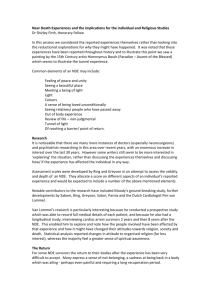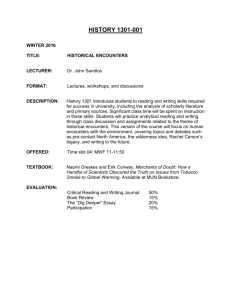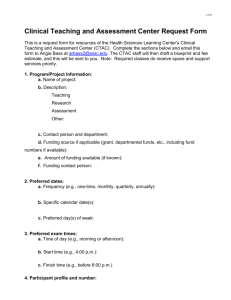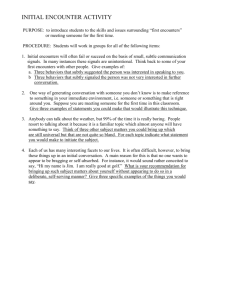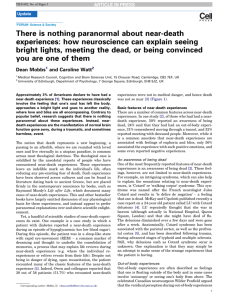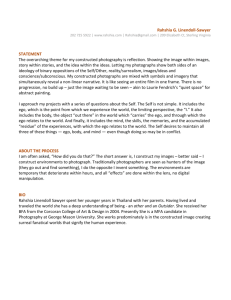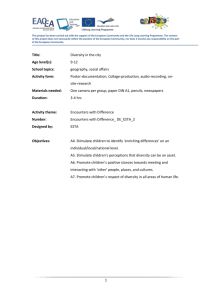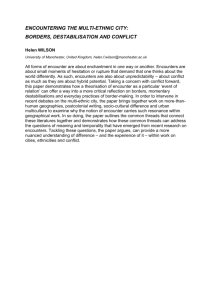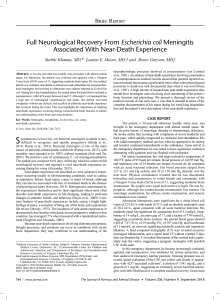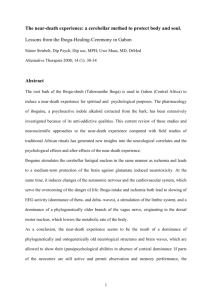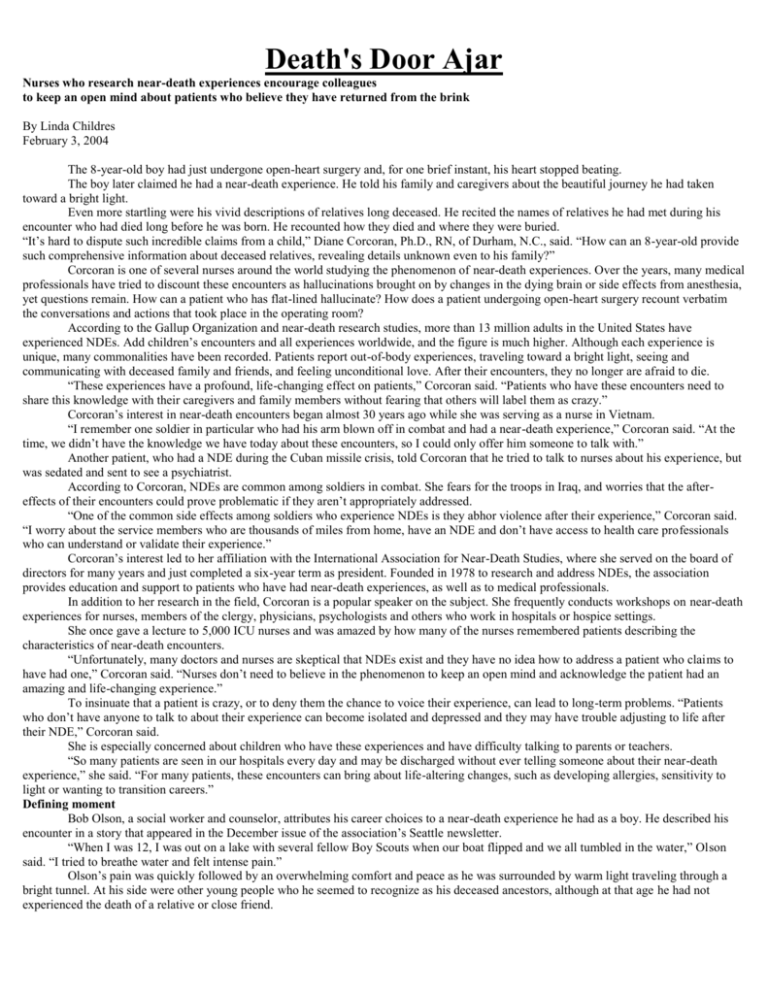
Death's Door Ajar
Nurses who research near-death experiences encourage colleagues
to keep an open mind about patients who believe they have returned from the brink
By Linda Childres
February 3, 2004
The 8-year-old boy had just undergone open-heart surgery and, for one brief instant, his heart stopped beating.
The boy later claimed he had a near-death experience. He told his family and caregivers about the beautiful journey he had taken
toward a bright light.
Even more startling were his vivid descriptions of relatives long deceased. He recited the names of relatives he had met during his
encounter who had died long before he was born. He recounted how they died and where they were buried.
“It’s hard to dispute such incredible claims from a child,” Diane Corcoran, Ph.D., RN, of Durham, N.C., said. “How can an 8-year-old provide
such comprehensive information about deceased relatives, revealing details unknown even to his family?”
Corcoran is one of several nurses around the world studying the phenomenon of near-death experiences. Over the years, many medical
professionals have tried to discount these encounters as hallucinations brought on by changes in the dying brain or side effects from anesthesia,
yet questions remain. How can a patient who has flat-lined hallucinate? How does a patient undergoing open-heart surgery recount verbatim
the conversations and actions that took place in the operating room?
According to the Gallup Organization and near-death research studies, more than 13 million adults in the United States have
experienced NDEs. Add children’s encounters and all experiences worldwide, and the figure is much higher. Although each experience is
unique, many commonalities have been recorded. Patients report out-of-body experiences, traveling toward a bright light, seeing and
communicating with deceased family and friends, and feeling unconditional love. After their encounters, they no longer are afraid to die.
“These experiences have a profound, life-changing effect on patients,” Corcoran said. “Patients who have these encounters need to
share this knowledge with their caregivers and family members without fearing that others will label them as crazy.”
Corcoran’s interest in near-death encounters began almost 30 years ago while she was serving as a nurse in Vietnam.
“I remember one soldier in particular who had his arm blown off in combat and had a near-death experience,” Corcoran said. “At the
time, we didn’t have the knowledge we have today about these encounters, so I could only offer him someone to talk with.”
Another patient, who had a NDE during the Cuban missile crisis, told Corcoran that he tried to talk to nurses about his experience, but
was sedated and sent to see a psychiatrist.
According to Corcoran, NDEs are common among soldiers in combat. She fears for the troops in Iraq, and worries that the aftereffects of their encounters could prove problematic if they aren’t appropriately addressed.
“One of the common side effects among soldiers who experience NDEs is they abhor violence after their experience,” Corcoran said.
“I worry about the service members who are thousands of miles from home, have an NDE and don’t have access to health care professionals
who can understand or validate their experience.”
Corcoran’s interest led to her affiliation with the International Association for Near-Death Studies, where she served on the board of
directors for many years and just completed a six-year term as president. Founded in 1978 to research and address NDEs, the association
provides education and support to patients who have had near-death experiences, as well as to medical professionals.
In addition to her research in the field, Corcoran is a popular speaker on the subject. She frequently conducts workshops on near-death
experiences for nurses, members of the clergy, physicians, psychologists and others who work in hospitals or hospice settings.
She once gave a lecture to 5,000 ICU nurses and was amazed by how many of the nurses remembered patients describing the
characteristics of near-death encounters.
“Unfortunately, many doctors and nurses are skeptical that NDEs exist and they have no idea how to address a patient who claims to
have had one,” Corcoran said. “Nurses don’t need to believe in the phenomenon to keep an open mind and acknowledge the patient had an
amazing and life-changing experience.”
To insinuate that a patient is crazy, or to deny them the chance to voice their experience, can lead to long-term problems. “Patients
who don’t have anyone to talk to about their experience can become isolated and depressed and they may have trouble adjusting to life after
their NDE,” Corcoran said.
She is especially concerned about children who have these experiences and have difficulty talking to parents or teachers.
“So many patients are seen in our hospitals every day and may be discharged without ever telling someone about their near-death
experience,” she said. “For many patients, these encounters can bring about life-altering changes, such as developing allergies, sensitivity to
light or wanting to transition careers.”
Defining moment
Bob Olson, a social worker and counselor, attributes his career choices to a near-death experience he had as a boy. He described his
encounter in a story that appeared in the December issue of the association’s Seattle newsletter.
“When I was 12, I was out on a lake with several fellow Boy Scouts when our boat flipped and we all tumbled in the water,” Olson
said. “I tried to breathe water and felt intense pain.”
Olson’s pain was quickly followed by an overwhelming comfort and peace as he was surrounded by warm light traveling through a
bright tunnel. At his side were other young people who he seemed to recognize as his deceased ancestors, although at that age he had not
experienced the death of a relative or close friend.
A white-robed, bearded young man who resembled pictures Olson had seen of Jesus Christ grasped his hands in greeting. Then the
view changed and he felt himself floating in the sky about 20 feet above the lakeside beach, where a small crowd was gathered around someone
giving artificial respiration to another person. Olson descended and the next thing he remembers is coughing up water.
His survival was considered a miracle because he had been underwater for a long time.
“Many of my life experiences reflect the rascally humor of unpredictable fate,” Olson said. “But the direction of my life since my
childhood NDE has been consistent in working with others toward personal and shared understanding.”
Debbie James, MSN, CNS, RN, of The University of Texas M. D. Anderson Cancer Center in Houston has become accustomed to
receiving strange looks from colleagues.
Sometimes, they will inquire as to whether she’s still researching that “woo-woo stuff,” and she answers them with a knowing smile.
James, a critical care senior nurse instructor, has gained a reputation for her work in the field of near-death experiences. She serves on
the international association’s board of directors and frequently lectures to colleagues on the subject.
Working in critical care has given her the opportunity to care for many patients who have had near-death encounters.
“I never thought their claims were weird or crazy,” she said. “I do remember thinking it was odd when we would resuscitate a patient,
expecting gratitude, and instead they were livid.”
As James learned more about these encounters, she began to understand why a terminally ill patient might not want to be pulled back
from the far reaches of what many described as “heaven.”
She became so intrigued with the topic that she based her master’s thesis on the subject of disclosure issues and NDEs. In her
research, she found that many patients who admitted to having these experiences were rejected, medicated or divorced by others who
questioned their sanity.
While working at Methodist Hospital in San Antonio, James was interviewed for a story on near-death experiences. At the end of the
newscast, viewers were told that Methodist would have a meeting for anyone interested in learning more about the phenomenon.
“That was 12 years ago and we had 110 people in attendance at that first meeting,” James said. “The group continues to meet once a month and
is composed of people who have had NDEs, their families, nurses, doctors, researchers and those just interested in learning more about the
subject.”
In her lectures to colleagues, James advises nurses to use open-ended questions if they sense that a patient has had a near-death
encounter. If a patient has just undergone traumatic surgery, the nurse might say, “Patients often tell me things they remember during surgery.
Please know I’m here if there are any aspects of your surgery that you’d like to discuss.”
“The important thing is for nurses to get patients to talk about their experience,” James said. “Nurses should practice active listening
and let patients know they won’t be judgmental.”
Part of the resistance to accepting NDEs in the medical community may be the ability to look at the phenomenon objectively. If these
encounters are real, then caregivers must consider the possibility of a human soul, an aspect not traditionally covered in medical and nursing
schools.
The subject also has caused some to question the validity of their own religious viewpoints.
“People who have experienced NDEs claim that the meaning of life is as simple as love and knowledge,” James said. “This
realization, combined with the fact that many people who have these encounters haven’t led saintly lives, can undo a lot of beliefs.”
Rather than being a religious experience, most people who have NDEs claim they’ve had a spiritual experience.
“I’ve had patients claim to see Buddha, God, a spirit, a light, a power,” James said. “Studying this phenomenon has convinced me that
death isn’t the end, it’s just a transition.”
Becoming a believer
As a nurse, Olma Sullivan, RN, of Southport, Maine, has provided end-of-life care to many patients, yet she never expected to confront her
own mortality at age 39.
After the birth of her daughter, Sullivan was diagnosed with an enlarged heart. One evening, while drifting off to sleep, her heart
began to pound irregularly, and then it suddenly stopped beating.
Sullivan still can recall in great detail the experience of floating over her daughter’s nursery, and traveling toward a wide, velvety
tunnel, where she experienced incredible light and warmth.
Before her own near-death encounter, Sullivan was skeptical of the near-death phenomenon. After many years and much research on
the topic, she finally felt comfortable confiding in others about her experience. She now firmly believes that these experiences are valid, and
works to help patients put their own encounters in perspective.
“On reaching that place of light, there was an incredible feeling of familiarity, of being home and a feeling of sadness at having to
leave even though I wanted to return home to raise my daughter,” Sullivan said.
Two days after her NDE, Sullivan was diagnosed with colon cancer. The doctor commented that she was so anemic he was amazed
she hadn’t experienced cardiac arrest. Sullivan believes she did suffer cardiac arrest, and that her near-death experience has made her a better
nurse.
“After my experience, I began working in the field of geriatric nursing and I think my experience has helped me better understand and
care for patients as they approach the end of their lives,” Sullivan said. “Many terminally ill patients want to talk about death, but are met with
resistance when they broach the subject with family or friends.”
When patients encounter Sullivan, they may find a kindred spirit who will talk about death and dying. She admits that before her own
experience, she didn’t have strong religious beliefs and hadn’t thought much about the concept of heaven or an afterlife.
But when patients ask her about death now, Sullivan answers their questions with the wisdom of her own experience. “I can tell them
with absolute certainty that life here on Earth is just the beginning.”
Contact Linda Childers at eastbaypr@aol.com.
Home • Subscriptions • Contact Us • Privacy Policy • CE Accreditation, NurseWeek Publishing, Inc. 2002, All Rights Reserved

